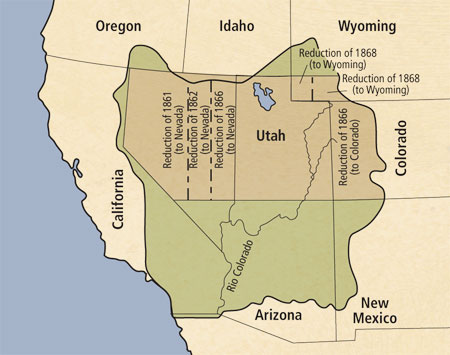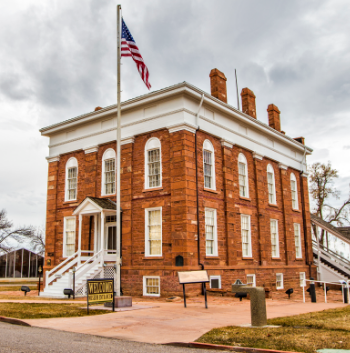Utah Territorial Statehouse State Park

The Territorial Statehouse, oldest existing government building in Utah (mapio.net)
On September 8, 1851, Governor Brigham Young placed his cane on the northeast corner of this block in Fillmore and designated this geographically centered location as Utah’s capital. The large open space, water & nearby building materials were favorable for settlement. In a political move to garner federal monies for the construction of the building, Gov. Young named the town Fillmore and the county Millard after President Millard Fillmore.
 Right: Originally the Mormons had grandiose visions for the West, as this map shows. The larger green area was the originally proposed State of Deseret, but by 1850 it was reduced to the official Utah Territory (darker tan area), and continually reduced over the years to its current size (lds.org)
Right: Originally the Mormons had grandiose visions for the West, as this map shows. The larger green area was the originally proposed State of Deseret, but by 1850 it was reduced to the official Utah Territory (darker tan area), and continually reduced over the years to its current size (lds.org)
Construction of a Territorial Statehouse commenced in 1852, the first wing of which was completed in 1855. The architect was Truman O. Angell, the same person who designed the Mormon / LDS Temple in Salt Lake City. Local red sandstone and native timber were used as construction materials. The statehouse was planned to be a monumental structure, with the current building being but the southern wing of a much larger domed building, but the majority of the structure was never completed. It was used by the 5th (1855), 6th (1856) and 8th (1858) Utah State Legislatures.
Development of the territory was slow. Accommodations at Fillmore proved inadequate and too distant from the center of activity at Salt Lake City, so the capitol was returned to Salt Lake City in December 1858.

As the focal point of the community, the Statehouse has served many functions over the years. First as Utah’s capital building, then as a school, dance hall, theater, jail, and even a hiding place for the Deseret News during the Utah War in 1857. By the turn of the century it had fallen into disuse and decay. The Daughters of the Utah pioneers were responsible for restoring the Territorial Statehouse and reopened it as a museum in 1930. The Utah State Legislature of 1947 returned to Fillmore to hold one session, to commemorate the centennial year of when the pioneers entered the Salt Lake valley.
Left: Since being restored, the Statehouse now serves as a museum and state park (mapio.net)
Today the building is the oldest existing governmental building in the state. It currently serves as a State Museum. It is also listed on the National Register of Historic Places. It houses a large collection of pioneer artifacts as well as items from the late 19th and early 20th centuries, many of which were used in the Fillmore area.
 Right: This hallway inside the statehouse features many photos of local history (visitsaltlake.com)
Right: This hallway inside the statehouse features many photos of local history (visitsaltlake.com)
Many artifacts are on display about the Paiute Indians who lived peacefully with the local farmers. Their chief, Kanosh, was a good friend to the community and was baptized a member of the Mormon Church. One room in the Statehouse museum houses artifacts from the Kanosh Indians. Chief Kanosh’s bow and arrows are on display.
Contact Info
Territorial Statehouse State Park & Museum
50 West Capitol
Fillmore, Utah 84631-0657
(435) 743-5316 or http://stateparks.utah.gov
Entry Fee: $2 / person
Source: Info adapted from http://www.greatbasinheritage.org/ and as noted by josephaw